NDVI Behavior in Savannas According to Environmental Aspects: The Pandeiros River APA Conservation Unit – MG
DOI:
https://doi.org/10.36403/espacoaberto.2020.32074Keywords:
Remote Sensing, Cerrado, Integrated AnalysisAbstract
In the historical development of the Brazilian Cerrado anthropic pressures caused systematic changes in land use and soil cover. Orbital remote sensing has become an important instrument for detecting this process, especially with the use of spectral indices, which permit understanding the dynamics of vegetation strongly influenced by in trinsic environmental factors. The objective of this article is to understand NDVI behavior in savanna lands located in the Pandeiros River APA conservation unit. Remote sensing techniques were used, especially the combination of spectral intervals. It was observed that environmental aspects influence NDVI behavior, with a decrease in savanna lands where sediments of quartzarenic soils are present and an increase in vereada areas where water is abundant. We conclude that remote sensing techniques associated with the integrated analysis of the environment produce more accurate analyses of the savanna present in the PR APA.Downloads
Download data is not yet available.
Downloads
Additional Files
Published
2020-10-22
How to Cite
SILVA, Lucas Augusto Pereira da; DE ALMEIDA, Maria Ivete Soares; LEITE, Marcos Esdras. NDVI Behavior in Savannas According to Environmental Aspects: The Pandeiros River APA Conservation Unit – MG. Espaço Aberto, Rio de Janeiro, Brasil, v. 10, n. 2, p. 71–85, 2020. DOI: 10.36403/espacoaberto.2020.32074. Disponível em: https://revistas.ufrj.br/index.php/EspacoAberto/article/view/32074. Acesso em: 7 dec. 2025.
Issue
Section
Articles
License
The copyright of articles published in Espaço Aberto belong to their respective authors with rights to first publication conceded to the journal. Every time that the article is cited and reproduced in institutional repositories or personal and professional web pages the link to the journal web page must be provided. The articles are simultaneously licensed under the Creative License Commons BY-NC-SA 4.0.



